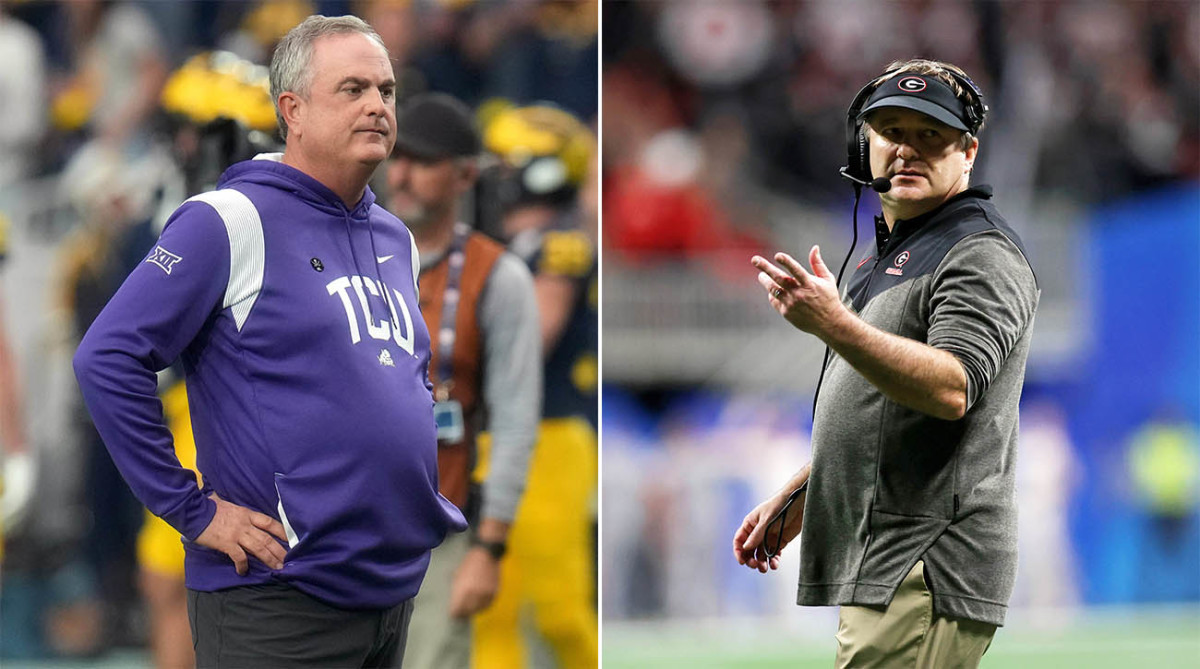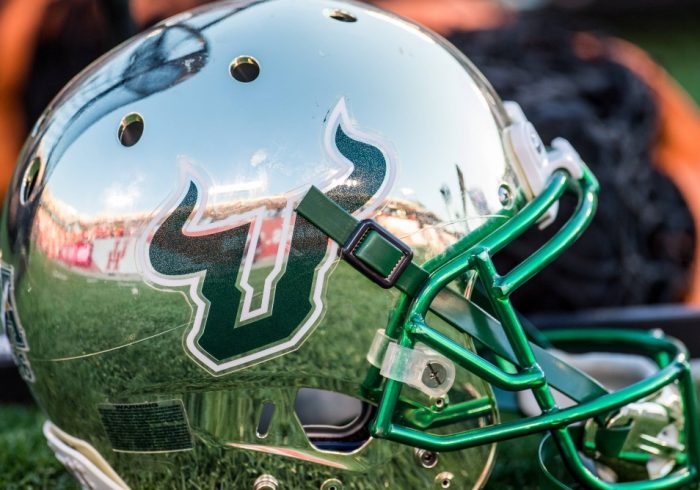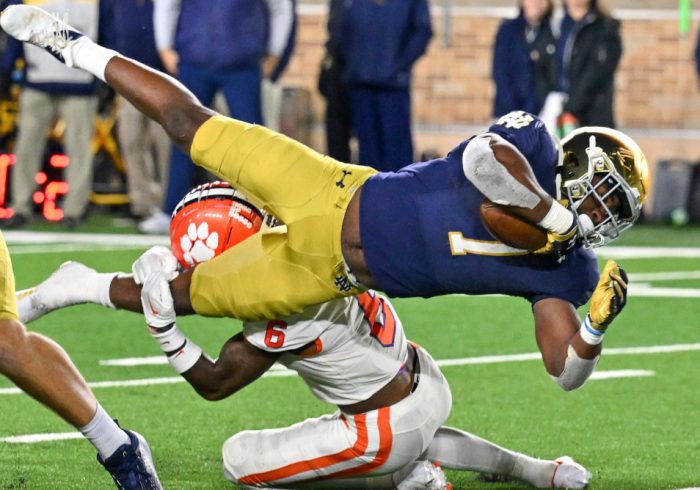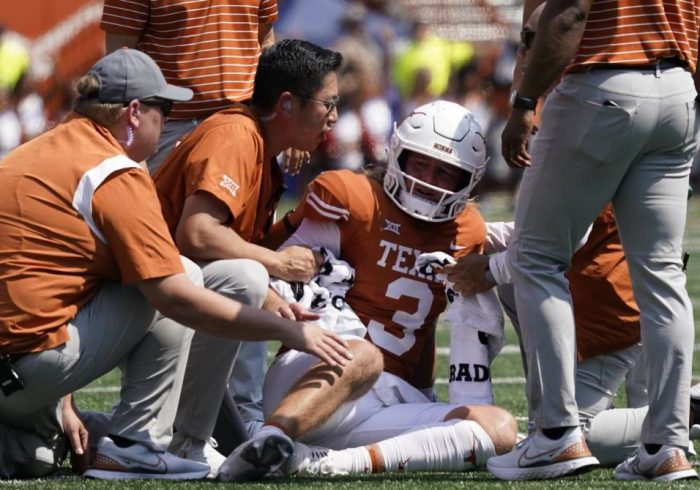The college football national championship is nearly here. Georgia and TCU meet in a title game that is in many ways a different proposition from the semifinals. Both teams had weeks to plan for the semis, then bring out whatever wrinkles they’ve been working on. The title game is a much more normal game planning scenario, but the semifinal performances brings up new questions for each team, especially Georgia, which admittedly did not play anywhere near its best in the Peach Bowl. Each team has questions to answer if it hopes to take home college football’s most prized trophy. Here are three for each.
TCU
1. If Georgia limits its turnovers and miscues … then what?
To call TCU lucky in the Fiesta Bowl would be dismissive, but the luck they worked to create cannot be ignored. It executed a perfect upset script against Michigan that was fueled in large part by three turnovers. Two were back-breaking pick-sixes, one of which helped the Frogs build their big halftime cushion. The other was a fumble on the goal line by the Wolverines after a play that likely should have been a touchdown was overturned by review. It’s one of two goal-line stops the Frogs got. The other came when Michigan ran a version of the Philly Special to disastrous effect that the Frogs saw coming from a mile away.
Michigan ripped off 39 points in the second half, albeit out of their normal game plan, and TCU was able to answer with haymakers of its own to keep the Wolverines at an arm’s length. Even the way the Horned Frogs got the two goal-line stops were advantageous. One, the ball bounced into the end zone for a recovered touchback and the other, instead of stymying the Wolverines at the 2-yard line (where the ball was snapped), they got a tackle for loss and assumed the ball at the 10 rather than being backed up. That amount of room offers an ability to run a different type of situational offense.
2. Can TCU have better results passing over the middle of the field?
Speaking of luck, TCU quarterback Max Duggan got the raw end of two tipped passes that ended up being interceptions. They certainly weren’t Duggan’s fault, and had he connected, the Frogs may have been able to build an even bigger lead.
You have to be on time and efficient throwing in that part of the field, especially against a defense as fast as Georgia. Ohio State’s C.J. Stroud was, as he went 13-of-16 beyond the line of scrimmage between the numbers. Can Duggan come close to matching that performance?
3. What is TCU’s play for Jalen Carter (and the rest of Georgia’s defensive front)?
Carter wasn’t terribly impactful on the stat sheet, and TCU did just neutralize Michigan interior defenders Mazi Smith and Kris Jenkins. But can they do that again against Carter? Part of Ohio State’s plan to mitigate Carter had Stroud on multiple bootleg plays and changing his launch point. He repeatedly rolled out of the pocket instead of dropping straight back behind the center where he would be a sitting duck. The strategy worked to mostly keep Stroud clean, and also gave him time to hit deep receivers, mitigating how much Georgia could just pin their ears back and rush. If TCU gets into a mode where it have to drop back pass for whatever reason, how will it keep Duggan clean?
Georgia
1. How will Stetson Bennett and Georgia take advantage of gettable shot plays?
When Michigan had success against TCU, it did so by taking shots over the top, like the flea flicker touchdown to Ronnie Bell.
The Wolverines hit another deep shot earlier in the game to Roman Wilson. Each play was a textbook situation to take a chance down the field. The Wilson catch came after a “sudden change” (a Michigan takeaway) and one of Bell’s deep catches came immediately after the Wolverines crossed midfield. Translation: scenarios when TCU should have been expecting those plays. Where will the Dawgs get theirs against a TCU passing defense that was 114th in the country in opponent passing plays over 20 yards heading into the Fiesta Bowl?
2. What is Georgia’s offense without Darnell Washington?
There is tremendous intrigue about what Georgia’s contingency plan is going to be without tight end Darnell Washington, or at least with Washington at less than 100%. Washington is dealing with a “soft tissue contusion and strain” in one leg according to Kirby Smart, and it remains to be seen if he can go in the title game. In his place will likely be backup tight end Oscar Delp.
What Washington gives the Georgia offense is a unique two-tight end set in which he lines up as a sixth offensive lineman and Brock Bowers is jumbo slot receiver. Whether Delp can fill in for Washington in the same ways—particularly as a run blocker—will be a subplot to this game. But Georgia could opt to go with one tight end more often, and more wide receivers now that Adonai Mitchell has proved to be a healthy and capable complement to Arian Smith and Ladd McConkey. But lighter personnel does take away what many assume is a decided physical advantage for the Dawgs against TCU’s 3-3-5 defense.
3. How will Georgia run the ball?
Speaking of that Horned Frogs defense, one thing Michigan never got quite figured out was how to effectively block TCU in the run game. Their pulling linemen didn’t handle the combination of the Frogs’ hard slanting defensive line and the angles, speed and timing with which their second-and third-level defenders flew down to defend the run.
Georgia’s run game may not be as predicated on a play like counter as Michigan’s, but it’s turned to plays like it (called gap scheme) more often this season. Georgia attacks the perimeter in the run game its own way, but one key play it uses comes with its own atypical blocking angles. The Dawgs’ pin/pull runs where, for instance, a wide receiver blocks down from the slot and a tackle pulls around, are different ways to get to the edge, especially with Washington as a lead blocker. They can be blocking for jet sweeps and tap passes that give the ball carrier a running start and increase the uniqueness of the play.
Pin/pull is something that many teams will try to run against TCU (Michigan did it as well). But just because it looks good on the chalkboard, doesn’t mean it always works on the field.
Bonus questions for both teams
Who screens better?
Georgia is one of the better screen teams in the country, with many of them being conventional ones to their running backs:
While TCU’s is unconventional.
Its shallow screen is an air raid offense staple, and one they used twice in the national championship game to score.
Either way, as changeups in the passing game, both teams bring screens to the table that add a different element to their offense.
Which QB run game takes most advantage of the element of surprise?
Sometimes it’s by design …
… or making something out of nothing.
Both Duggan and Bennett have an exceptional gear as runners that help keep defenses off balance and can punish a D that isn’t ready. They’re used judiciously as runners in designed situations, but both are seriously quick and if they get lost, look out.



